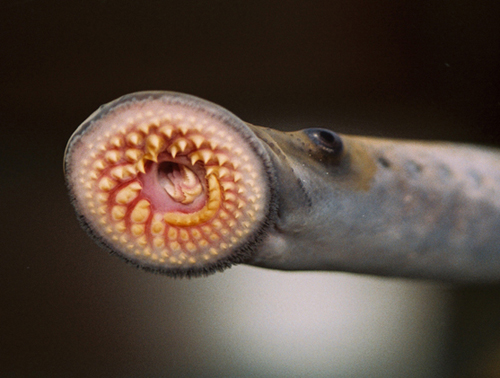
Form and Function
If one has never seen a sea lamprey, also known as Petromyzon marinus, it could be mistaken for an eel, learn the difference click on the word eel (New York State Department of Environmental Conservation, 2013). They have long cylindrical bodies, which are smooth, scaleless and has bilateral symmetry. Sea lamprey are the largest of the lamprey species and typically range from 5.98 inches to 11.81 inches in length as adolescents. When the species is full grown, it can span from 11.81 inches to 39.37 inches (Cherry, 2011). There are two easy ways to distinguish age, color and dorsal fins. During adolescence, P. marinus are darker green/brown with a grey underbelly and the dorsal fins are far apart. As sea lampreys become adults they become lighter, turn a brown/grey color and their dorsal fins are closer together (Cherry, 2011). The difference between male and female sea lamprey is that males have a ridge along their back and females have a crest-like fin behind their vent (Cherry, 2011).
There are two ways that sea lampreys are classified, one is that they lack a jaw, putting them with a group of fish called Agnathans and the other is that they are invertebrate, which categorizes them under the subphylum Vertebrata (Cherry, 2011). P. marinus have a cartilage skeleton. They have seven layered gills, for breathing (USGS, 2013). As said before, sea lamprey have two dorsal fins, two eyes, one eye located on each side of the head, a nostril in front of each eye towards their mouth. Their mouth is an oval shape and has numerous rows of large teeth pointing inward that would remind one of a shark (Cherry, 2011). Sea lampreys also lacks swim bladders and a lateral line system (Cherry, 2011). Swim bladders are gas-filled organs that help a fish control its buoyancy and to act as a stabilizing agent; therefore sea lamprey are bottom dwellers and attach to rocks by their mouths. This is where they lie dormant until a host fish comes along. A lateral line system would allow them to detect other animals by vibrations and movement in the water. These physical characteristics are adaptations that allow sea lamprey to feed on their prey.
As described in the life cycle page on this website, the third phase, transformation, is when the ammocoetes go through drastic changes in form and function, which will define them as adult sea lampreys. These adolescent sea lamprey have now developed their mouth, teeth, eyes and kidneys, which allow them to live in saltwater (Cherry, 2011). The new, adolescent sea lamprey continue into the fourth phase of the sea lamprey life cycle. During the fourth phase the adolescent sea lamprey become parasites to fish, which will help move them to survive bigger and deeper waters, and they also develop sexual reproductive organs. This stage is very important because now these parasitic fish or sea lampreys interact with other species, by feeding on them and draining their bodily fluids (Cherry, 2011). When attaching themselves to a host fish sea lamprey can move anywhere and receive constant nourishment.
